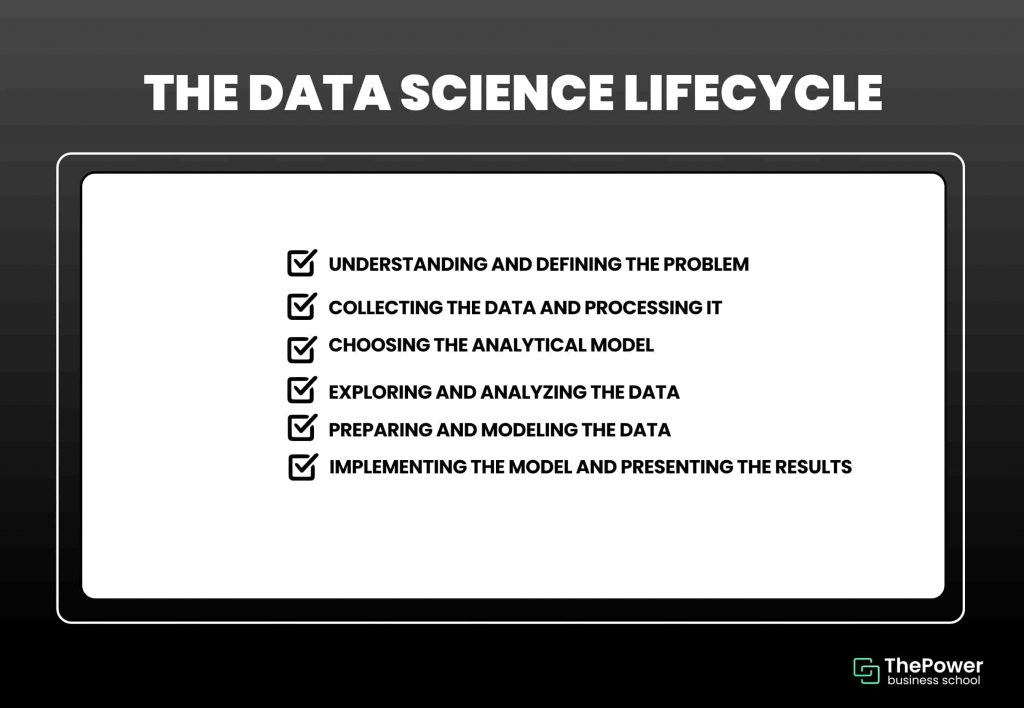
Franco Brutti
Data science is one of the most promising and in-demand technological fields today.
Thanks to advances in technology and artificial intelligence, this field is already an invaluable asset for all types of businesses and industries.
In fact, according to the U.S. Bureau of Labor Statistics, the number of jobs may grow at a rate of 31% per year. Translation: this is one of the careers with the best job opportunities and growth prospects.
Interested in getting started in the world of data science? Then you've come to the right place.
This article will work as a definitive guide to get you started in this sector. We will tell you about all the concepts you need to know about, the different applications of data science, the best tools and more.
What is data science?
Data science is the combination of the scientific method, mathematics, statistics and programming into a single field of study.
In addition, it also incorporates domain-specific knowledge, that is, specific subjects such as economics and software development, depending on your area of application.
This field focuses entirely on analyzing unimaginable amounts of information, transmitted in structured and unstructured data.
It also designs analytical models, creates mathematical models, performs predictive analysis and research, and conducts experiments, among other applications.
The goal of data science is to process incalculable amounts of information and then, to extract statistical trends, patterns, variables and margins of error. And then to turn all that data into invaluable information for strategy and research.
The importance of data science today
Today, amidst the rise of the digital age, information is more valuable than ever, and we are just beginning to grasp its full potential for the future.
Like mathematics, statistics and the scientific method, data science is applicable to all types of industries and businesses.
On the one hand, it can be applied in a myriad of business strategies, for example, to design data collection and research models. It can even be implemented to optimize production lines and supply chains.
On the other hand, it’s fundamental for the development of artificial intelligence, as well as software development in general and the creation of large-scale statistical models.
For example, it’s indispensable for algorithms used by search engines such as Google and Bing. And also for social network algorithms, and even network systems.
The life cycle of data science
This is what data science looks like in practice:
Understanding and defining the problem: this will be the object of study. From here you will get the questions to answer and the hypotheses to solve. And so, you will be able to set the objectives of the subsequent data analysis.
Collecting data and processing it: this step includes both the collection of existing data and data acquisition. In turn, the integration of multiple data collection sources and models.
Choosing the analytical model: with the data already processed, it’s time to experiment and discover which analytical model best suits your study objectives.
Exploring and analyzing the data: after having chosen the model, it’s time to study the data and look for patterns, trends, variables and outliers.
Preparing and modeling the data: this is where you start to eliminate missing values, define variables and process the data in general. At this point, you can test the model you have chosen and reshape it according to the data you obtain.
Implementing the model and presenting your results: either to customers, executives, team leaders or collaborators. This is where you communicate the data obtained, either through reports, briefings or presentations.

This model is applicable for both companies and research teams. For example, you can use this model to conduct a market segmentation study. You can also apply it to develop an algorithm for a digital product.
Now, while you can apply this framework in a myriad of scenarios, this is not an absolute framework. In other words, you don't have to follow it to the letter in each and every one of your projects.
It will all depend on the objectives of the data model, as well as the information you get from your analysis.
Data science applications
So how does this discipline apply in the real world?
In a nutshell, data science is the cornerstone of the following areas and their various tasks:
Data mining: that is, the whole process of collecting data and variables through different sources.
Data processing: including data cleaning, elimination of missing values and inconsistencies. It’s also fundamental for the transformation of data into different formats.
Statistical model development: statistics is a key part of data science. For example, for the creation of linear regression models, clustering models and time series models, among others.
Data visualization: whether to find patterns or to illustrate and represent them in different formats, such as graphs and tables.
Machine learning: machine learning is one of the foundations of artificial intelligence. And data science is fundamental to machine learning, both for the creation of algorithms and their implementation in software development.
Deep learning: this is the branch of machine learning based on the creation of neural networks, and is vital for the creation of advanced artificial intelligence models.
So what exactly is it for?
Let's look at concrete examples of data science in different industries, as well as its uses and areas of implementation:
AI development: in all its presentations, from facial recognition models to language processing models such as Chat GPT.
Cybersecurity: data science plays a vital role in small and large-scale anomaly detection, log analysis and threat management. Also to develop and optimize security systems and authentication methods.
Software development: especially in product development, but also in the implementation of agile methodologies. It’s also used for software testing, creating automations and processing user interactions.
Economics and finance: in this sector, this discipline is vital for risk analysis, fraud detection, market analysis and transaction processing. It’s also used to create commercial and business strategies.
Marketing: for example, to analyze market trends and consumer behavior trends. In turn, to create segmentation analysis and predict demand for products and services.
Medicine: in this field, data science is perfect for research, as well as for managing medical records and transactions. It can also be used for diagnostics, outcome forecasting and drug development.
Research: both for the development of mathematical models and for advanced studies. For example, robotics, astronomy and quantum physics.
What do you need to know before specializing in data science?
You can go into this area if you have a good academic background in management and marketing. However, these are the fundamental prerequisites:
1. Mathematics
Mathematics is the fundamental basis of statistics, analytical models and algorithms used in data science.
Let us clarify: you don't have to be Albert Einstein.
However, it’s best to have fairly solid notions, especially in linear algebra, matrix operations, algorithms, calculus, graph theory. And of course, statistics.
And the more you know about mathematics and its different applications in statistics, the better.
Mathematics will help you design algorithmic models and understand how to put theory into practice. It will also allow you to analyze and understand data much more clearly.
2. Statistics
All facets of data science depend 1000% on the use of statistical models and probability models.
On the one hand, statistics will provide you with all the theoretical concepts and tools you will need to develop complex analytical models and algorithms.
On the other hand, it will provide you with the necessary methodologies to put into practice all kinds of theoretical models in all kinds of scenarios.
3. Programming
In order to put statistics into practice and handle so much information from so many sources, programming is essential.
Programming is present in all facets of data science, from data collection to the optimization of algorithmic models.
This area is fundamental for data manipulation and process automation - also for visualization, interaction with databases and integration with other tools, among other applications.
Best programming languages for data science
There’s a wide variety of languages used in data analysis. However, these are the most powerful and also the favorites of thousands of specialists and companies:
1. Python
Python is a general programming language, and it’s one of the most user-friendly languages to get you started in programming. At the same time, it’s one of the most versatile and powerful tools in the technological world.
Python is already one of the most widely used languages in the world thanks to its simplicity and versatility. It’s perfect for software development, but it also has a vast library of resources for data science.
In other words, it’s the ideal tool for combining software development and data science in the same workspace.
And if that wasn't enough, it has one of the largest technology communities today.
2. R
R is a medium-difficulty language and a great favorite for data analysis. It offers a huge number of libraries and integrations fully dedicated to data science, both for visualization and data modeling.
This language has a fairly solid statistical base, making it perfect for complex studies. Not to mention that it’s the best choice for statisticians.
Moreover, it can integrate well with other languages. Moreover, being one of the most popular, it has a community of millions of users from all over the world.
3. SQL
SQL (Structured Query Language) is a language entirely dedicated to database management and manipulation. And while it may be more complex than Python, it’s one of the most convenient for data science.
In other words, this language is phenomenal for data extraction, but especially for data processing and manipulation. It’s also an excellent choice for integrating large-scale databases.
Jobs in data science
Now, let's look at the roles that make up a team specialized in data science:
Data scientist: in charge of the overall implementation of data science, from information gathering to the creation of predictive models, among other tasks.
Data engineer: in charge of designing, building and maintaining data infrastructures. Also in charge of developing workflows and implementing integrations for processing and analysis.
Data analyst: in charge of cleaning and transforming data for later analysis. He/she is also in charge of looking for patterns and trends, detecting and defining variables and establishing margins of error. And of course, presenting the data.
Machine learning engineer: the person who designs machine learning systems and applications. He/she is also in charge of creating machine learning models and algorithms, including neural networks, and their large-scale implementation.
Data architect: in charge of designing the architecture of data systems, developing schemas and data models. Also in charge of information governance and the implementation of security strategies for the systems.
Data visualization developer: in charge of designing and developing visualization techniques. He/she is also in charge of representing data in visual presentations and reports that are easy to communicate and understand.
Data translator: this is the link between business and data scientists. He/she is in charge of defining business problems and objectives and translating them into theoretical and statistical concepts. He also collaborates directly with the data visualization developer to communicate the data to the parties involved.
Note: in many teams the tasks of the data visualization developer and the data translator are delegated to the data analysts.
Ready to get started in data science?
Data science is already one of the fields with the most applications, the highest demand and the best forecasts for the future.
A data science major represents a whole world of career opportunities, regardless of industry.
In fact, for many, data science is one of the careers of the future, not to mention that it's already one of the most promising career paths today.
And now, we're eager to learn more about your experience in related areas and your aspirations and goals in data science.
Do you plan to take an apprenticeship, do you want to opt for an MBA? Tell us all about it in the comments.
Oct 14, 2022








